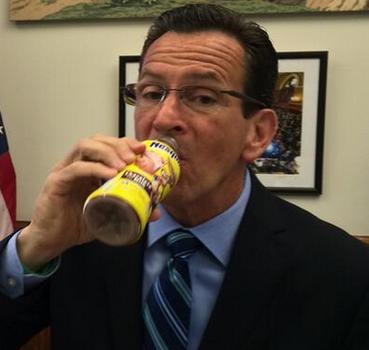
What is going on around here? Is there anything better than a glass of Hershey’s or Bosco? Doesn’t chocolate make everything better? State Senators Anthony Musto and Andres Ayala, both of whom represent Bridgeport, voted to ban chocolate milk in schools. Fortunately, sanity prevailed. Governor Dan Malloy vetoed the bill on Thursday, noting “I love chocolate milk. I love chocolate shakes. I like chocolate. I’m also a big milk person. So, looking at this, this was the right decision to make.”
All Connecticut state senators voted to ban the sale of chocolate milk in schools in an effort to lower sodium intake, including senators Musto and Ayala. State Senator Joe Crisco, who represents the Naugatuck Valley, also voted to ban chocolate milk. The problem with the diet of Connecticut students isn’t too much chocolate milk. Maybe the problem is too much Crisco. And how could Musto vote against chocolate milk when one of the preeminent union activists David Bosco is helping his reelection?

Nutritionists who support Malloy’s veto of the bill say chocolate milk has essential nutrients such as potassium, calcium and vitamin A.
“I actually drank some chocolate milk in my office this morning,” Malloy said on Thursday. “To reach, at least for an adult, the sodium content, you would have to drink more than 10 of those.”

In his veto message, Malloy announced: “Ideally, students will choose to drink unflavored, nonfat milk. Chocolate milk contains unnecessary calories, sugar, as well as sodium. Research shows, however, that when chocolate milk is removed as an option, total milk consumption goes down and milk waste increases, presumably because students who do not like the taste of unflavored milk throw it away.”
The National Milk Producers Federation issued the following statement from President and CEO Jim Mulhern on Malloy’s veto of legislation banning chocolate milk from Connecticut school lunchrooms:
“It’s encouraging to see reason and common sense returning to the debate over chocolate milk in schools. As a recent university study made clear, schools that remove chocolate milk from the cafeteria are simply throwing the nutritional baby out with the bathwater. They deprive kids of calcium, protein and other needed nutrients while they increase waste and boost costs. Certainly, obesity is a serious problem among today’s youth. But the answer isn’t to ban chocolate milk. Connecticut is not required to pass this legislation to keep its federal school meals funding. Federal nutrition standards specifically allow schools to serve fat-free chocolate milk as part of reimbursable meals and in cafeteria a la carte lines. Governor Malloy is to be congratulated for thinking this through, and not opting for the quick, easy but wrong solution.”


Only chocolate milk? What about the poor food our children receive?
Almost no one was aware cocoa powder added to milk contained a tiny amount of sodium (myself included). The bill that was brought forward by the CT legislature had good intentions to stop manufacturers from adding sodium (salt) to beverages that are being consumed in public school cafeterias. I am pretty sure no one intended this to be a ban on chocolate milk. This was an honest mistake that was cleared up by the Governor. It was however unfortunate the bill had to be vetoed in its entirety to fix the chocolate milk issue. Our politicians need to do a little more research before they try to save the world.
From yaleruddcenter.org/newsletter/issue.aspx?id=16, Dec 2009:
The dairy industry’s national marketing group, the Milk Processor Education Program, is launching a new $1 million initiative to promote chocolate milk, especially in schools. The initiative has the potential to create a large increase in sales because “more than half of all flavored milk is sold in schools,” and “the importance of flavored milk goes beyond the school market because it is a key growth area for milk processors,” according to a presentation on www .milkpep.org.
Chocolate milk is not the nutritional equivalent of non-flavored milk. It is significantly higher in calories, sugar (often high-fructose corn syrup), and sodium. It usually contains artificial colors and flavors.
The Web site www .mypyramid.gov shows the daily discretionary calorie allowance for children. After eating “essential” calories, which are the minimum required per day to meet nutrient needs, “discretionary” calories are the extra calories allowed from added sugar and fat. The number depends on age, sex, and level of physical activity. The majority of American children have a limited number of discretionary calories each day. Girls between ages nine and 13 who get fewer than 30 minutes a day of moderate to vigorous physical activity have only 130 discretionary calories a day, half of which would come from one serving of chocolate milk for lunch.
I love chocolate milk! I have not seen chocolate milk in the Bridgeport schools for some time. The breakfasts, however, are the worst high sugar carbs bread. Nothing nutritional at all except the milk and juice. No more nutritional snacks. Just garbage breakfasts. They used to have eggs.
Cholesterol, Steve; and I admit I had three eggs this morning and I probably shouldn’t.
Protein as opposed to 100% sugar and carbs.
Go for it, Steve. No one is going to live forever regardless of how miserable we make ourselves trying.
We should ban BOSCO!
I will drink to that!
If the above article is correct, we now have an idea of the type of bill on which “All Connecticut state senators” can agree! Pretty incredible, isn’t it? And one OIB reader can probably tell us how much debate went on to get this unanimous verdict.
Isn’t the chocolate in chocolate milk a lot like “incentives” offered to get people to behave in “better” ways? And if moderate use is a commonsense standard in many other areas, what was the importance of this legislation? Is it easier to deal with chocolate milk than the State budget? And with NPR talking about the waste generated from discarded vegetables and fruit in school meals, what is going on? Time will tell.
If forced to compare this bill against the leading issues confronting our state, sure … it seems silly.
However, why the bill gained such support is pretty clear when you look at the public testimony from experts.
If you wish, look here:
www .cga.ct.gov/asp/menu/CommDocTmyBillAllComm.asp?bill=SB-00048&doc_year=2014
Some might see it as “Big Brother,” but we all end up paying for lots of the preventable medical costs associated with childhood obesity.
Let’s try where we can–yes, with evidence and common sense–to turn the vicious circle into a virtuous cycle … for the people, rather than the corporations.
Great comment on the Courant site today:
www .courant.com/news/connecticut/hc-chocolate-milk-veto-0613-20140612,0,5699268.story
As President of the Association of School Nurses of CT and a pediatric Primary Care Provider, I’m disappointed that important school health legislation can get lumped together with this issue, and suffer the consequences of this veto. The media frenzy around making this the “chocolate milk bill” is disturbing–as is the Governor trivializing the issue with his tweeted photo. This bill was important to all the nurses who are trying to work smarter and improve the time kids spend in class. The only legitimate concern about providing chocolate milk should be a concern about students having access to Calcium and Vitamin D–so why isn’t anyone else talking about perfectly reasonable nutritional alternatives like yogurt, low-fat cheese, and fortified OJ (which actually has more calcium than milk!)? I’m not opposed to giving kids reasonable nutritional options, including a version of chocolate milk without so much high-fructose corn syrup/calories, artificial additives, let alone the sodium. I’m troubled by our faulty legislative and bureaucratic process that led to this problem. I also think that if we’re going to address legitimate health and nutrition concerns, including obesity and bone health, we need to appreciate that chocolate milk is not the solution, and needs to be kept in proper perspective–it’s a treat, not a nutritional staple.
And a lot of plain milk is part of that waste. Some kids plain don’t like milk and chocolate milk is one way around that … not perfect.
This was a racist vote and I’m sure Ron Mackey will back me on this. Chocolate Milk is singled out–they found nothing wrong with White Milk, Vanilla Milk, or Strawberry Milk. Malloy played it right–he needs voters of all flavors to win in November. The chocolate-colored skins are coming for Ayala and Musto.
Another ridiculous comment as usual, Joel. Thankfully, no video to go along with it.
Not so fast, Godiva!
www .youtube.com/watch?v=39q3MUZLTDM
There is a good bit of debate whether milk is good for you at all. That ‘food pyramid’ we all know listing dairy at the top was put out by the dairy council. We believe milk is good for us because the dairy council told us so. Go figure!
Let the kids drink water. That is the best thing for you but water is free. Where is the fun in that? The US has the most nutrient-rich urine in the world.
From Dr. Oz:
www .willitsnews.com/ci_23981339/dr-oz-heres-milk-news-thatll-shake-you
Google ‘is milk good for you’ and you will get any number of articles telling you it is not. Of course you can also find a number of articles telling you pot is good for you. So take it for what it is worth.
Subsequent to the 2009 Rudd Center newsletter, excerpted above, the USDA came out with “MyPlate” along with updating of USDA food patterns for the 2010 Dietary Guidelines for Americans.
Source: www .choosemyplate.gov/food-groups/downloads/MyPlate/ABriefHistoryOfUSDAFoodGuides.pdf
Children need calcium … last I heard water doesn’t have that. Milk for children is great, for adults not so much.
Or you could take a pill. People, like me, who are lactose intolerant do just fine without milk or dairy of any kind. Calcium is added to just about everything. Second only to vitamin C. Vitamin D, a fat-soluble vitamin, can actually be toxic in high enough doses. Although that would be a lot of D and difficult to do.
David,
As noted by the President of the Association of School Nurses of CT and a pediatric Primary Care Provider (I posted this above yesterday morning):
“The only legitimate concern about providing chocolate milk should be a concern about students having access to Calcium and Vitamin D–so why isn’t anyone else talking about perfectly reasonable nutritional alternatives like yogurt, low-fat cheese, and fortified OJ (which actually has more calcium than milk!)?”
Malloy was wrong about this. Worse, he decided to flaunt his stand with the Nestle Quick-chugging stunt, to address his election-year veto, against the clear evidence on this, e.g., see the testimony by his own Commissioner of the Dept of Public Health, Jewel Mullen, MD, MPH, and others.
Almond milk and Coconut milk is not only a healthy option but extremely healthy.
How about banning fries? Fatty, greasy, weight inducing. Let’s see what Dan’l has to say about that?
Don’t these idiots in the legislature have anything better to do? Or are they just trying to justify their existence?
Agreed, expounding on the evils of chocolate milk is absurd. There must be bigger fish to fry rather than banning chocolate milk. Oh my, I said that evil word, “fry.”
They must ban Godiva Chocolate Milk only.
They should also ban finger food.
LOL, good one Godiva2011.
Nice to see everyone has their priorities in order.
There is low-fat chocolate milk in Hooker school, my kids get it all the time, and also want it at home of course.
Dr. Oz, he may be a quack, says low fat is worse than whole milk. The ‘stuff’ they put in to replace and take away the fat could be worse for you than the fat. Also, the hormones they use to make a cow make more milk (as well as bigger cows and chickens) could be leading to premature puberty. This has been studied in Cuba. The US has tighter laws about this but some of these hormones get through and we drink more milk and eat more meat than people in Cuba do.
*** Everything in moderation, no? *** Maybe if they educate the kids and parents in better eating and change the public schools’ breakfast and lunch menus to something more healthy than the cheap high-calorie foods they have now, and get back to basics like Phys Ed and other gym activities to get their butts out of their seats! Stop blaming chocolate milk and taking the easy way around a continued growing health problem in the public schools system. ***
How ironic, they vote to ban chocolate milk, but wouldn’t vote to ban city employees serving on the City council. Just saying!
Good big-picture point, Lisa! Thanks.
Ironic and absurd.
Lost of wasted time and research for a no-brainer public-health policy, which then Malloy vetoed and turned into a P.R. stunt.
Touchdown by Lisa Parziale!
Imagine that, doing something of substance at the legislative level.
All that EVIL chocolate milk. IT. MUST. BE. STOPPED!
Yes Sally, oh, the perils of drinking it! As of today in my adult life, I am still drinking it, as is the governor. It began in my childhood. All joking aside, aren’t there much more important issues the Senators should be addressing? This is pure folly, ridiculous in my opinion.
Clearly nothing is “evil” about choc milk. If you think it is best to ignore the evidence-based recommendations of experts on sensibly reducing known contributors to childhood obesity, that’s your right.
And yes, clearly there are comparatively greater issues facing our state.
I do agree. This is a foolhardy misuse of Senatorial time and state resources. Foolhardy.
Reducing intake is one thing, but banning it is absolutely unnecessary. In moderation, low-fat chocolate milk is a viable option as it is a source of vitamin D and calcium. There are foods that contribute to childhood obesity much more so than chocolate milk, particularly fast foods that are big no-no’s. Yet there are children who are frequently eating those foods because it requires no prep and it’s relatively cheap. Obesity is the fault of the parents. Concentrating on issues that would benefit the State is the responsibility of the legislators, banning chocolate milk shouldn’t have even been a consideration.
Godiva, re your statement: “Obesity is the fault of the parents.”
A CT Dept of Public Health survey finds that 29.8% of CT’s kindergarteners are either obese (13.9%) or overweight (15.9%). The CT Dept of Public Health survey found that Hispanic (22.6%) and non-Hispanic black (18.3%) kindergarteners were significantly more likely to be obese than non-Hispanic white (10.1%) kindergarteners.
Source: See the Feb 27, 2014 testimony of Myra Jones-Taylor, PhD, Executive Director of the CT State Office of Early Childhood to the CT State Public Health Committee at www .cga.ct.gov/2014/KIDdata/Tmy/2014SB-00048-R000227-Myra%20Jones-Taylor,%20PhD,%20Executive%20Director%20of%20the%20Office%20of%20Early%20Childhood-TMY.PDF
So Godiva, in your opinion, would poverty be the entire fault of the parents too?
So I guess your assumption is every non-white family is impoverished?
Godiva, the current statistics wouldn’t allow a reasonable person to make such an assumption.
Speaking of which, if we assume your parents-are-the-cause-of-obesity assertion is true, would you then conclude that, proportionally, Hispanics and non-Hispanic black parents are worse parents than white parents regarding caring for their children’s nutrition and body mass?
Clearly, that wouldn’t make sense to most people, but maybe to you?
If it doesn’t make sense, then what other factors are in play?
Do we want to subsidize foods for daycare and school breakfasts and lunches that are widely acknowledged by health experts as significantly contributing to childhood obesity, so we can then pay for the medical care required to treat the negative effects of preventable childhood obesity?
Seems a vicious and wasteful circle to me, that very few benefit from.
As a nanny state, it must keep some type of extra reward–sinful as it is–for our compliant behavior, right? Brief conversation with a food service vendor as to why graham crackers and crumb cakes are considered breakfast in Bridgeport schools–they comply with the federal mandated % of grain servings per meal. Really? Yes, really.
Jennifer, I’m not sure what your question means above.
As for “nanny state,” anyone paying federal taxes helps foot the bill for childhood obesity, sorry.
“Consider that the annual bill for treating the medical problems of 12.5 million obese children in the U.S. runs to $14 billion. What’s more, children covered by Medicaid are almost six times as likely to be treated for obesity-related problems as children with private insurance.”
Source: www .bloomberg.com/news/2012-05-31/obese-children-navigate-minefield-of-calories-and-bad-ads.html
My question is, graham crackers and crumb cakes, essentially a cookie and a cupcake are under federal guidelines an acceptable way to incorporate more grains into a federally funded diet to help prevent childhood obesity. That makes about as much sense as banning chocolate milk. Legislators pick and choose what they think will be popular and still keep the federal funds flowing. Right now phasing out butter and salt in diets of school children is mandated. Teaching moderation and get up and move seems to be a better, multi-health approach rather than making something contraband, which usually makes something even more desirable. Whatever happened to the fitness award children earned from the president? In those days what were the childhood obesity rates? Not sure but would be good to know.
Perhaps so Mr. Spain, but these families whose children are insured by Medicaid are also likely to be recipients of food stamps, so therefore the opportunity to feed their children healthy meals is not out of reach. If a parent sees their child is at an unhealthy weight, isn’t it their responsibility to rectify that?
Yogi Berra loves chocolate milk.
My case rests.
Hello, 49 comments regarding MILK. This just shows again what a shithole Bridgeport is.